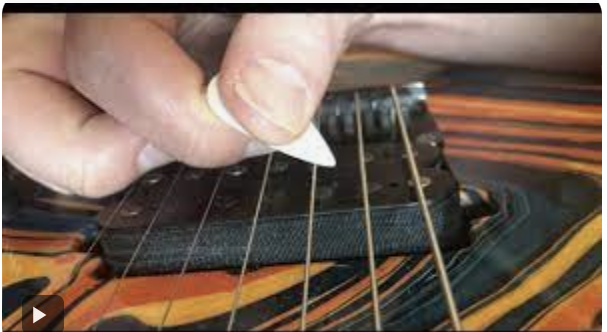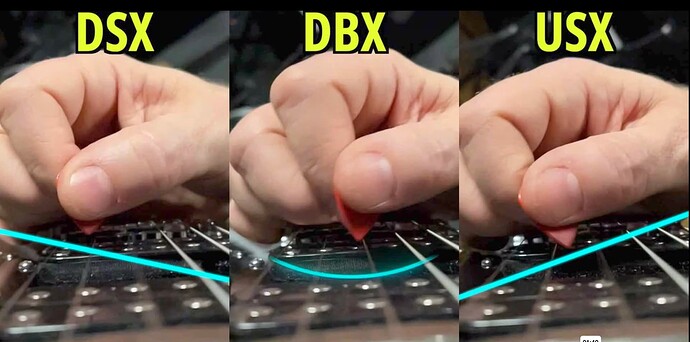I’ve been trying to improve my picking speed and accuracy, but cannot figure what’s limiting me. I feel like I’m doing DBX, but any feedback is welcome on improvements. I should note that I’ve observed my palm never plants when picking. If anything, the thumb side of my picking hand seems to be lightly touching the strings. All videos are slow motion but I can post normal speed variants if helpful. Thanks!
Regular speed versions of the videos would help. To me this doesn’t look like DBX. I think I see the upstrokes stuck and sort of ‘loop’ over the strings.
Is your goal DBX? You mentioned wanting to be able to pick on a diagonal in the other thread.
I wasn’t necessarily trying to achieve DBX, it’s simply what I thought I was observing in my videos. I was advised by an instructor that I should pursue USX/DSX and that my diagonal line needed improved. Here are normal speed clips:
Could you post a video of your fastest trem picking speed? That would help figure out what motion you gravitate towards.
Why not adhere to what your instructor says?
@kgk Agree. For the past 3 weeks that is exactly what I’ve been working towards. After a lot of experimentation and recording myself playing, my picking still appears to have a pendulum type back and forth as opposed to the USX/DSX being on a straight path. Additionally, my instructor has advised me to angle my pick like the following picture, but I can’t seem to achieve that without getting severe “garage spikes”, and the feeling of discomfort in my arm. Almost as if I have to contort my entire arm to flatten the pick’s angle.

Upon watching the RDT series, I noticed the DBX technique and began to wonder if I should use this pick angle shown below but do USX/DSX as opposed to DBX.
In any case, specific feedback I am seeking is how do I straighten out my escape angles and get rid of any curved or looped picking as mentioned further up the thread. Part of me wonders if my current inability to achieve straight diagonals is a problem of something else (wrist, forearm, elbow, etc.).
Have you gone through these yet?
That should give you options on several ways to do one way escape. I mentioned this in your other thread, but the extreme downward slant won’t translate to USX if the motion that drives it isn’t USX compatible. Same is true of the opposite where an upwards slant won’t necessarily create DSX. I can see why your instructor suggested the slant though as sometimes a “posture” does help to encourage a motion/trajectory.
Main thing, if something doesn’t work, throw it out and move onto something else that does work.
After finding a fast motion from the Primer section I linked above, @Pepepicks66’s tremolo suggestion is a good place to go next
@joebegly Thank you, and yes I did do the test. My results were quite varied, but I doubt this is uncommon.
I definitely need to experiment some more, but I think I also need to scale back and pull fewer levers at once. During the past few weeks I’ve tried altering many aspects of my picking in broad strokes. The results got quite ugly at times.
As I mentioned in my other post, I learned that my alternate picking style has been downward slant for the better part of my playing career. This was perhaps introducing inefficiency and flubs in my playing depending on directions and # of notes. That led to the above videos where I tried to make adjustments.
I will be posting a trem picking video later, but I will admit I’ve never spent much time on trem picking; I find it challenging. I’m probably malnourished in this area to the point of having little speed. More to come!
Actually in the other thread you said you’ve been DSX (downstroke escape) for 25 years. Though the slant isn’t the (only) important part, usually people that slant downwards have USX (upstroke escape). Ignoring the slant, have you identified which direction your pick strokes escape yet?
The whole tremolo thing, I definitely feel you on that. If you’ve never used it in your playing it could feel weird. What might happen is you’ll tense up and instantly become an elbow player. Honestly, even if that’s a false positive, it just might help you identify what a truly efficient picking motion is - what it feels like. I think that’s in line with your inclination to back up and remove variables. Just try to get something working and move on from there.
Right, I’ve definitely been there (most of my life lol!, before finding Troy’s site).
The recommended approach for success is
- Find a fast single escape motion (doesn’t matter if USX or DSX)
-
- Tremolo is the easiest test since you only have to worry about the picking hand
- Still staying on one string, make sure you can sync the picking/fretting hand
- Start changing strings, paying close attention that you are changing strings that make sense with your escape motion
To that last point, the lick you’ve posted is a nightmare scenario because it requires so many string changes in varying directions. Neither Eric Johnson nor Al Di Meola could play that lick at their fast speeds because they have (mostly) a single escape motion.
So, I must admit that I had things confused. The pick angle I’ve been attacking at for the better part of my playing career has been upward pick slant and downward escape.
@joebegly @Pepepicks66 Examples from different angles of my fastest trem speed. I can’t maintain these for very long. My entire arm tightens and it seems that I go into elbow motion. Things fall apart quickly.
When you say you can’t maintain for very long, do you mean before you feel tightness? Does your entire arm tighten to the point that your picking locks up?
I’m not sure what level of “tightness” you experience, but I believe that fast playing will inherently have some degree of tightness (in the form of noticeable muscle contractions) in the arm. Not to the point of pain or discomfort, but definitely not as “loose” feeling compared to having your arm perfectly relaxed.
Also, elbow motion isn’t bad, so if you naturally gravitate towards elbow motion, you don’t have to avoid that.
Finally (just a personal preference here but might help you), I find that sleeves get in the way of your forearm anchoring, which can make your picking feel less accurate, especially if your only anchor point is your forearm (which in your tremolo picking, that’s the only anchor point).





